My Resmed S9 was warning that the motor was beyond life expectancy so I purchased a new 11 and it's been awful. It's hard to describe but for the past 4 nights I have been waking up feeling as if I can't get enough air. Eventually, after a couple of minutes, I take the mask off as I feel like I am hyperventilating. Then I try to go back to bed but the feeling of not getting enough air continues. Eventually, after about an hour of staying up without the CPAP on I try again and everything appears to be working fine and I go back to bed. Desperate to figure out what the heck is going on I installed an SD card and downloaded OSCAR. I don't know how to read these charts and I was hoping you guys could help me out. I noticed that my Tidal Volume was < 500 until about 5 minutes before the event when it ranged 800-1100. It stayed around 800 on my 2nd and 3rd attempt to put the CPAP back on and go back to bed. Not sure if that's a clue or not. Thank you in advance for any help you can provide...what if anything do you see or what suggestion do you have for me?
Graph of my entire 2 hour sleep:
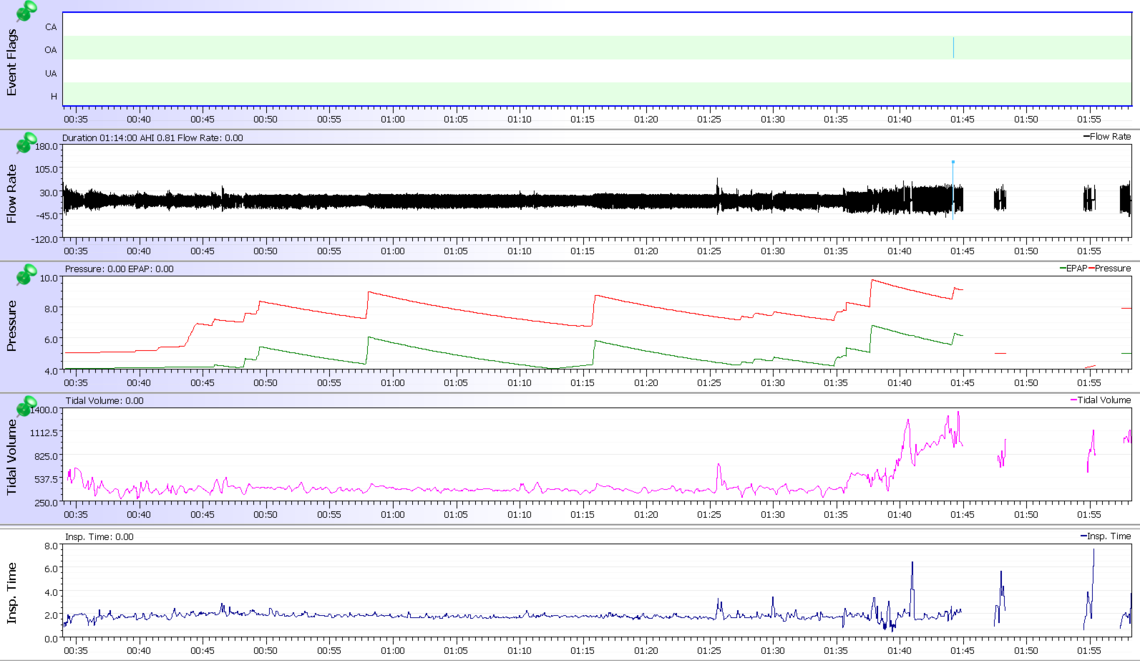
Here I am zooming in to about 5 minutes before I woke up and then showing my two attempts to go back to bed
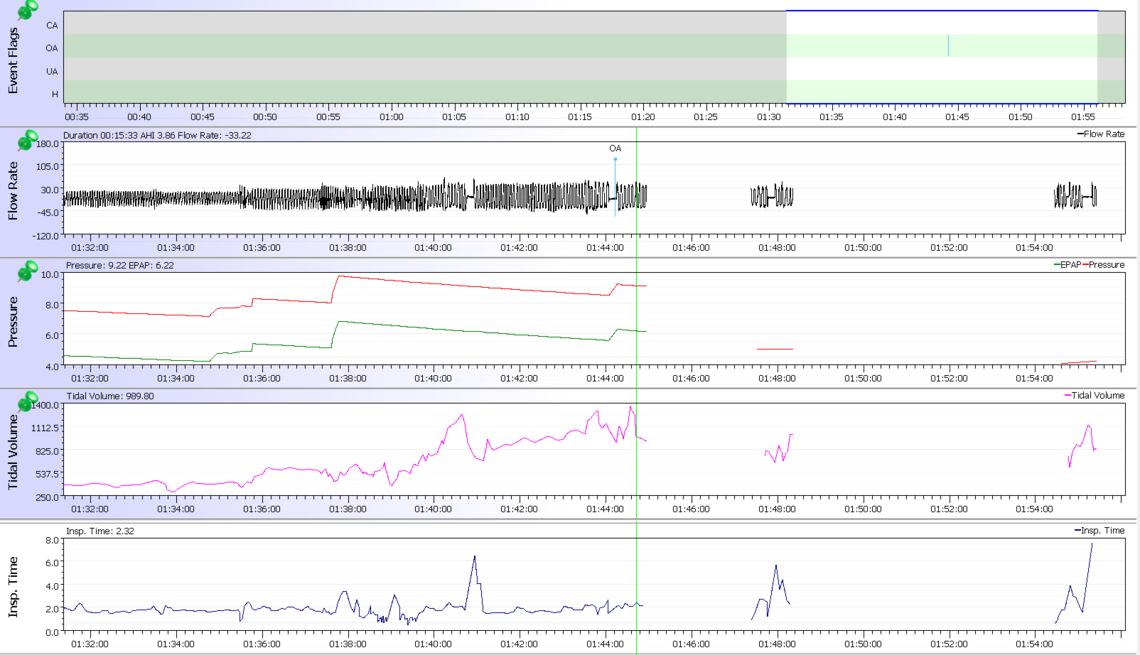
That is very unusual. Have you set up the A11 the same as the S9? There are not that many differences between the S9 and A11, but one is that the A11 has two modes; the standard one and the For Her mode. The S9 would be using the standard mode.
From the graphs posted it seems you are breathing really deeply, because you feel you are short of air, I expect. The only time I have felt short of air is when the pressure is set or goes too low. But in your case it seems that IPAP is at 8 cm or higher, which should not leave you short of air. One graph you may want to display is mask pressure. It is a calculated pressure based on the set pressure and flow rate. It would be interesting to see if the mask pressure is staying up.
It would also be helpful to see the whole Daily report screen. On a PC you just press the F12 key to get a complete screenshot. It is also helpful to suppress the Pie chart and the full month calendar so more of the detailed setup shows. To suppress the calendar just click on the triangle beside the date. To suppress the Pie chart go to File, Preferences, Appearance, and uncheck the display pie chart box. The menu on the right if displaying can use up screen space too. I believe the F10 key toggles it on and off.
If you can post another chart with the mask pressure and the rest of the details showing, I may be able to offer further comments. Just post one screenshot as when you post multiple ones it can trigger the spam filter here and the post gets delayed.
Thank you for your reply. Although I have been using a CPAP I am new here and to OSCAR, I should have known you would need the settings. Last night after creating these posts out of desperation I went back to the S9 and had my first good night sleep in several days. I am posting the settings from the Air 11 below plus the S9 along with the data from last nights sleep. Thanks again!!
Air11 Settings:

S9 settings and one night sleep data:
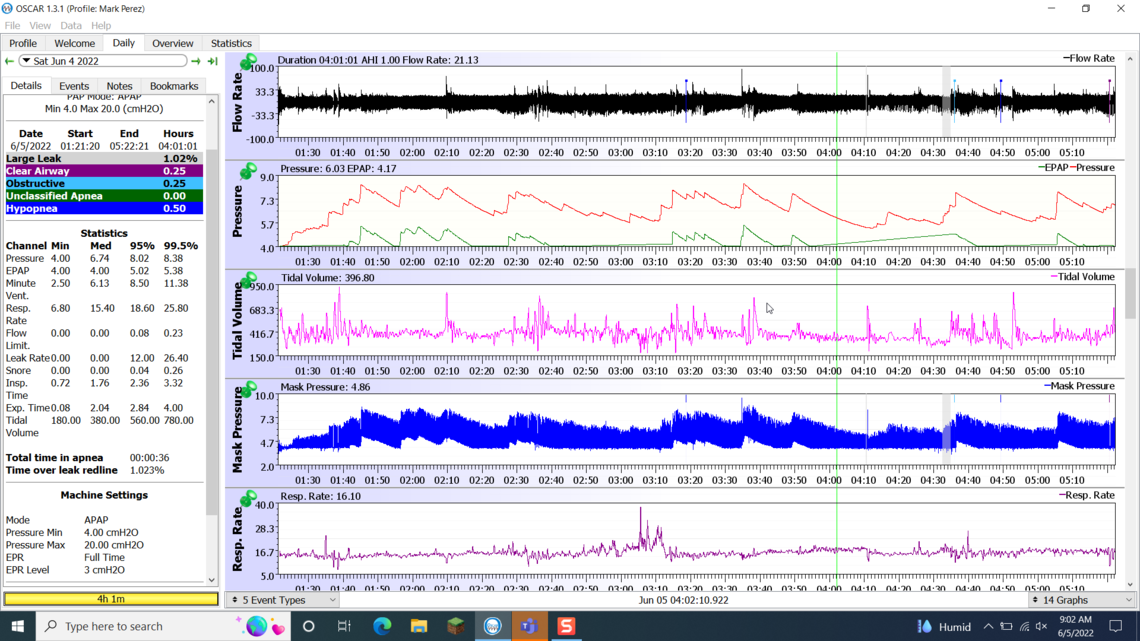
That helps a lot. One issue I see, but unrelated to your problem, is that OSCAR is reporting that you are in fixed pressure CPAP mode on the A11, but the graphs clearly show it is in Auto APAP mode. Must be a bug in OSCAR. I still use Sleepyhead. I believe OSCAR is supposed to be compatible with A11, but it appears is is not fully...
What I see unusual in the A11 graph of the mask pressure is that there are times when the mask pressure drops very low, below the minimum pressure of 4 cm that it is supposed to always maintain. See the screenshot below where I have highlighted the areas. It may be worthwhile to expand out some of those areas and see what may be happening first. It's possible that it is a chicken and egg situation. Are the deep breaths causing the mask pressure drop, or is the mask pressure drop causing the deep breaths?? You might see that if the time scale is expanded out in one of these. The one at 1:37 seems to be the worst.
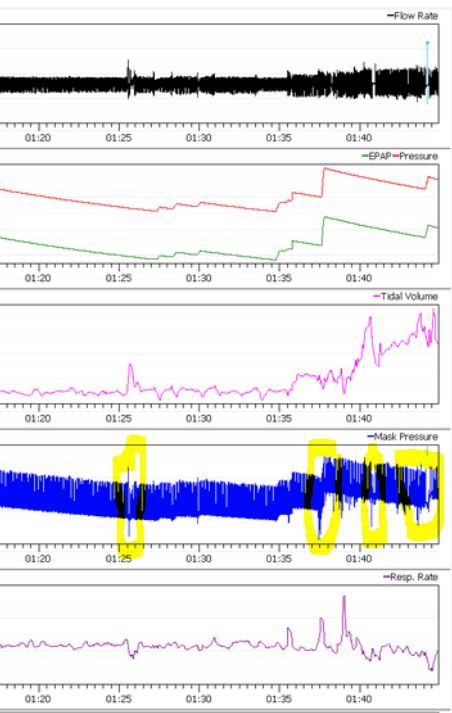
These machines are designed to always maintain a minimum of 4 cm of pressure. It is possible that this particular machine is defective and cannot respond quickly enough to dropping pressure. Depending on where you got the machine it may be hard to convince them of that possibility. They may respond to a screenshot clip showing in detail what is happening.
One other thought I had was that you may want to try setting the machine to a fixed CPAP pressure to see what happens. That may let the machine respond better to quick deep breaths. Not sure, but it is easy to try. I would suggest a fixed pressure of 8 cm based on your data that you posted. Then it may have to be fine tuned up or down to get an acceptable number of OA events. But, 8 cm should be close. This is a bit of a work around to the underlying issue though if the machine is defective and not responding quickly enough.
You don't seem to be using the Ramp feature. If you want to try it, I would suggest setting the Ramp Time to Auto, and the Ramp Start pressure to 7 cm if you want to go with a fixed CPAP mode of 8 cm. That should be comfortable to go to sleep. The Auto ramp feature hold the pressure at the ramp start pressure until it decides you are asleep and then ramps it up to the set pressure of 8.
Hope that helps some. I would be interested in seeing a screenshot of that event at 1:37. It may tell what is happening first.
Sierra thank you for your reply! Here are two more screenshots where I zoomed in on the areas you highlighted, does this tell you anything more?
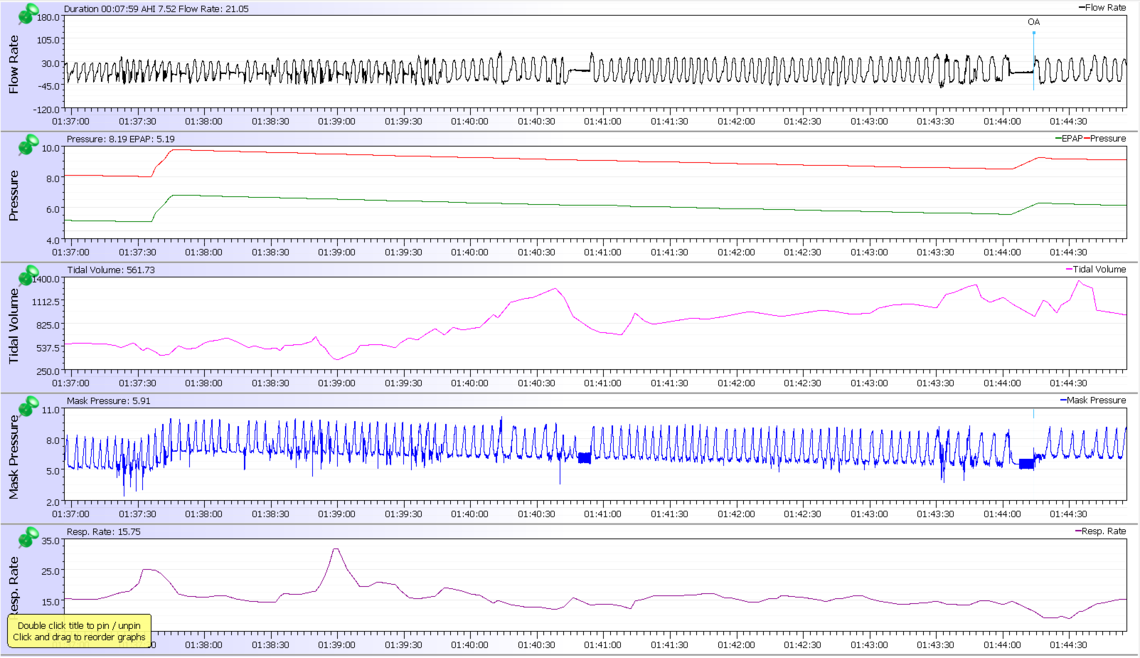
Zoomed in further
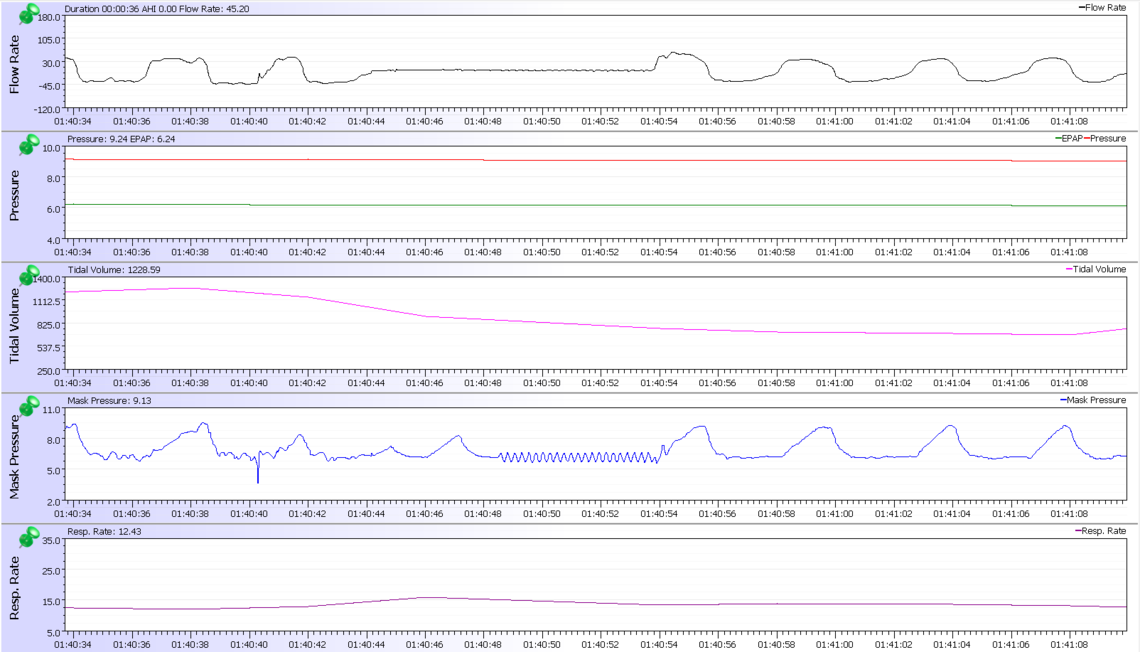
From what I can see on the one you zoomed in further it appears the mask pressure drop happened on a reasonably normal increase in flow. I am thinking there may be an issue with the machine's response to increasing flow and maintaining pressure. If you post more screenshots it is helpful to put the cursor on the event of interest and that should draw a vertical green line that goes from graph to graph so you can relate correlate each graph more easily. This is much easier for you to do as you can move the cursor back and forth sideways to compare multiple different events.
The event near the left of the top image at 1:37:30 would be interesting zoom in on. It appears to have multiple drops in pressure while the flow rate is reasonably normal. But the exhale (down) flow rate seems to have a lot of noise on it. One possibility is that the flow rate sensor is not measuring flow reliably and that in turn is affecting pressure.
You could also search the S9 graphs to see if there is anything similar in them. If not, that would seem to eliminate you and the way you are breathing as a source of the disturbance.
Just of interest that squiggly line in the middle of the bottom graph is the machine pulsing the flow to test for the type of apnea you are having. If it is obstructive the cycle up and down in pressure is more extreme. And if it is an clear airway or central event then the wave in the pressure line will be narrower. This event did not last 10 seconds so it was not flagged. the next event lasted longer and did get flagged as an OA event.
Thank you again Sierra. I searched the S9 and I don't see anything similar. Thanks for sharing what the squiggly meant.
If it is a bad flow rate sensor is there any way for me to confirm that, do these things run diagnostics that might point to a bad sensor?
Here's a screenshot showing the mask pressure dipping to 3.41 for some reason when everything else is steady.
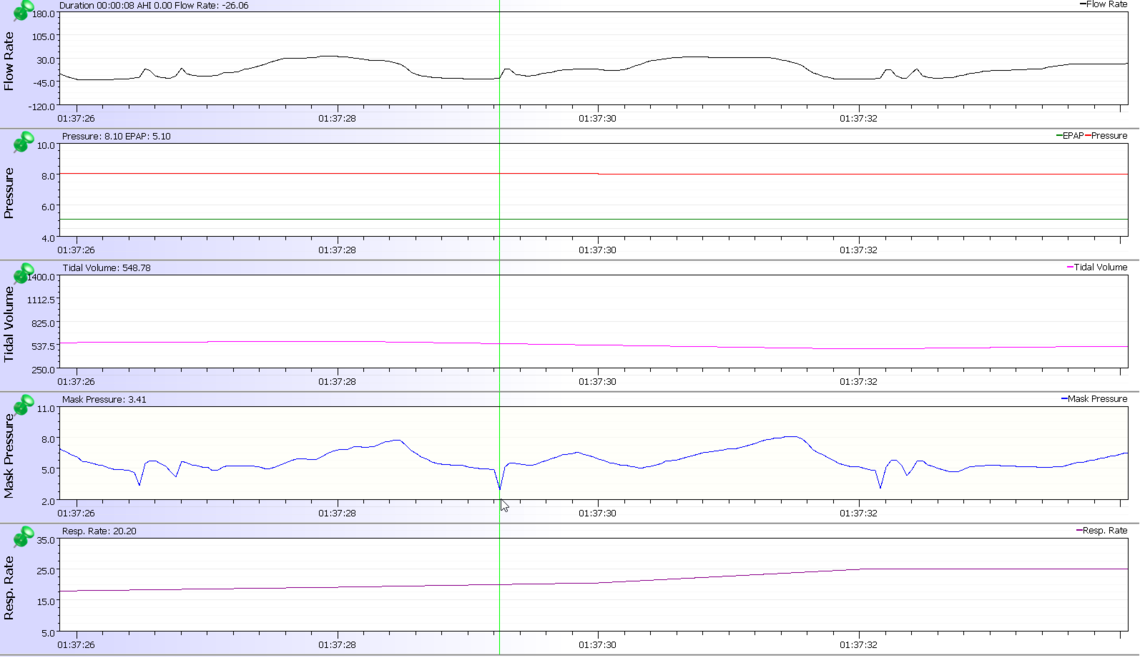
I am not aware of being able to troubleshoot the problem any more than you have done. I think I would talk to your supplier and try and get them to accept a return and replacement of the machine with a new one. Your screenshots should be useful in verifying that the pressure is not being held constant, and in fact is dropping for no reason. I am just guessing but the machine pressure control system may be programmed to use flow as an anticipatory input to determine when to increase the fan speed. When flow goes up the pressure will tend to drop if the fan speed does not increase. Possibly a defective flow transmitter would contribute to the pressure dips.
You also have your S9 data to show that it is not your health problem and the S9 works well when the A11 does not. My wife has a S9 machine which has been displaying the motor life exceeded warning for about a year now, but it keeps on ticking. That is good because the on line supplier of machines in Canada seem to have no stock of new machines.